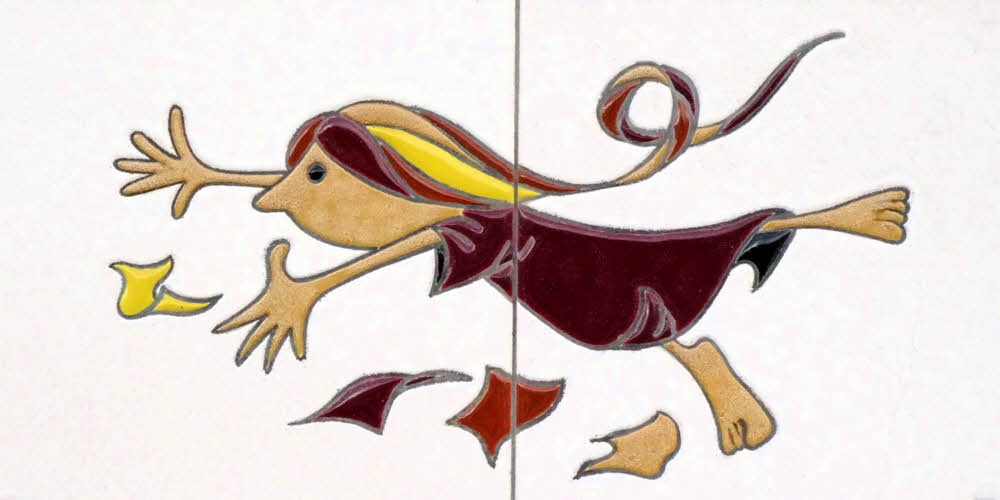
When I was a little kid, shoe stores had x-ray machines. True.
You don't remember this because I'm older than you are, but I remember. Sticking my feet into the machine and watching myself wiggling my toes around inside a potential new pair of shoes was the best part of buying shoes.
The idea was that customers could check the fit, see it for themselves, and be sure that everything was A-OK, but I liked to see the wiggling bones. That was the part I liked. This was before TV, and almost better than TV was when we got it, years later. Watching your own feet move around inside your shoes was almost better than seeing 30 minutes of Howdy Doody squirming around with Buffalo Bob's hand stuck up his back.
Almost. X-rays were a modern miracle of merchandise marketing, and the time I spent looking at my feet was definitely a loop of time forever unreachable by the intensely (creepily) unsettling Clarabell the Clown. I still don't understood why a man in a terror-suit was named Clarabell, and what the hell his connection was to Howdy Doody, and I don't want to know. Not today. Tomorrow, ever. He/it be dead now forever, we hope, and gone.
And then they took all the x-ray machines away. They were called "shoe-fitting fluoroscopes", according to Wikipedia. Buggers. All gone.
"The bones of the feet were clearly visible, as was the outline of the shoe, including the stitching around the edges." Yep. That was it. Including "two other viewing portholes on either side [enabling] the parent and a sales assistant to observe the child's toes being wiggled." And then they took all the x-ray machines away. Up to then the early 1950s had been a lot of fun.
And what if "there was not enough data to quantify the level of risk until atomic bomb survivors began to experience the long-term effects of radiation in the late 1940s"? They survived, didn't they? But the machines disappeared anyway. What's a little radiation burn here and there? Kids grow out of stuff all the time, pretty quick too, mostly.
Well, a few years later television came to town, and the rest is misery. Until then I ran around outside, played baseball, fed peanuts to squirrels, watched ants crawl around on peonies, and entered grade school. Very few if any of my toes fell off, and my shoe fit didn't seem to suffer the loss of x-rays, but I missed the scientific method as applied by gimmicky machinery to an annual footwear purchase ritual.
Choice matters.
Especially for older merchandise consumers, like adults. Especially cranky ones like me. Especially cranky ones carrying backpacks around and grunting inside clouds of flies. That's why custom packs are a good idea. There's a custom pack to fit the hump of every grump. Because. That's what custom means, doncha see?
I tried last year about this time. Heard good things and contacted Mr. Sam Jepsen of JepPaks. He got confused. And backed away. Now if I try to go back to the JepPaks web site and see what he's up to, I get only "Website Expired. This account has expired. If you are the site owner, click below to login." So I guess that's over. No more Sam, no more JepPaks.
This year I contacted Mr. Christopher Zimmer of Zimmerbuilt. Sounded good. Got a positive response. He's even made a pack that was sort of vaguely related to what I want, the "ZB2 - Gowler". So I figured he'd be open to trying to do something off the beaten track and back in the bushes about half a mile, which is what my design is like — odd but very simple to make. So I pulled together my specs and dug up a bunch of photos of my original self-made pack, and. Haven't heard a damn thing back from him.
Two possibilities: He's either otherwise occupied, with illness, a vacation, his real job, a crisis in the family, or whatever, or he's blowing me off by playing dead.
"Effort or effit." That's my new motto. I'm not going to whine and beg, so effit then. I'll find a way to make the pack I need, maybe next winter. Meanwhile, I've got a pack on order from a real company, a Mountain Laurel Designs "Prophet". It's close enough to what I can put up with to work for me. I can fudge a little, find a way to stiffen it, add capacity flexibly, add compression.
Its relatively generous design should let me move the furniture around, depending on which party I'm headed for.
Hey, I did set off in the summer of 2013 on a 12-day, no-resupply trip carrying a North Face 26L "Verto". And came home again. It can be done. With some fudging. Though that was not fun.
What I did was to customize it. Get the drift here? Customize.
I sewed on two ginormous side pockets which together equaled about a third the volume of the pack bag. Then I added another pocket in front (confusingly, the "front" is the side of the pack that's way out back). This contributed another big boost to the pack's volume. And then I started off carrying my hammock, tarp, and under-quilt in a largish stuff sack lashed on top. I probably had about 45L to work with in the modified pack, and even more in the stuff sack, and stowed more and more things back inside the pack bag as I ate my way through the trip's provisions.
So things can be done.
Also, mistakes were made, lessons were learned, pain was encountered. Such is life among those living desperately.
Which is why I want to get back to where I left off, with a really good and really custom pack. And it looks like I'll have to do it all myself. Such is life, period. OK, fine. I'll do it then. But not at this moment, I guess, because I don't have materials here, or time, or a sewing machine. Right now.
And yes, this is really necessary. Necessary and normal. We're all different even in the midst of our seeming sameness. Last year I tried two different packs. Both worked. Both were wrong. The first was an REI "Flash 45" and it had all sorts of confusing little straps routing themselves here and there and beyond, and the shoulder straps made me howl in pain. The second was a Granite Gear "Crown 60". Tighter, lighter, bigger, better-designed, kinda, but the shoulder straps also made me howl in pain. And a pocket ripped the first time out. And the hip belt was permanently too big.
And I'm a good fit. If I buy clothes in my size, they fit. Like they were made right for me, you know? Pants, shirts, socks, underwear — all OK. Not so much with packs. I don't know. Something's off. If you can't fight 'em, can't join 'em, then effit, 's what I say. Eff-M-All, and make your own. Which I guess I'll have to do when I can, if I can.
Which brings us around to actual evidence. Because I'm not making up all of this. Not all of it. I have the U.S. of A.'s own Force d'Air on my side here. Right here. On my very own side. And them fellas is smart some of the time. "In the late 1940s, the United States air force had a serious problem: its pilots could not keep control of their planes." See? That's Step One, observe symptoms. "'You never knew if you were going to end up in the dirt.' At its worst point, 17 pilots crashed in a single day. The two government designations for these noncombat mishaps were incidents and accidents, and they ranged from unintended dives and bungled landings to aircraft-obliterating fatalities." Check.
Step Two is to locate the cause of said symptoms. This can be hard. "After multiple inquiries ended with no answers, officials turned their attention to the design of the cockpit." Hmmm. Maybe if we take sort-of average pilots, and measure the hell out of them, and average all the measurements, we'll be able to design a cockpit that will fit...all pilots, they thought. So. What? Then what?
Zero. "Out of 4,063 pilots, not a single airman fit within the average range on all 10 dimensions. There was no such thing as an average pilot. If you've designed a cockpit to fit the average pilot, you've actually designed it to fit no one." A true WTF moment, folks, sponsored by your tax dollars, or those of your parents, or your grandparents, depending, of course.
Step Three is solving the actual problem. Which for the Air Force was not the crashing planes (that was a symptom), or pilots that didn't fit the planes (that was another symptom), but the lack of understanding that "there was no such thing as an average person". And to solve the problem the Air Force had to actually do something. Because "any system designed around the average person is doomed to fail." Rather than finding hikers or pilots average enough to fit the ideal backpack or fighter-plane cockpit, the solution is to customize the hardware so it will fit actual humans.
As for the Air Force, "they were able to focus on fitting the cockpit to the individual pilot. That's when things started getting better...They designed adjustable seats, technology now standard in all automobiles. They created adjustable foot pedals. They developed adjustable helmet straps and flight suits."
As for the outdoor industry?
What. We have 16 different packs from one company, all made on the same basic plan, all in your choice of Medium or Large, so take your pick. You're sure to find a great fit, assuming that you like a three-foot-tall, six-pound, top-loading pack (empty weight) with two tiny mesh pockets outside, no noticeable compression, and a hip belt that fits anyone with a waist size from 32 inches to 48 inches. And you can stand shoulder straps carved from wood. And you think maroon and yellow go well with the outdoors.
And if you're a woman, well this year they're introducing a special model just for you. It's exactly the same as their real pack, except it costs more and has a tiny label over on the side that says "Designed Especially for Women".
Love it or effit.
Meanwhile, back at the ranch: "By discarding the average as their reference standard, the air force initiated a quantum leap in its design philosophy, centered on a new guiding principle: individual fit. Rather than fitting the individual to the system, the military began fitting the system to the individual...it was a practical solution to an urgent problem.." Pretty good for government work, right?
Step Four Let's see more custom-designed and custom-made backpacks because I've got a body and goals and attitude that aren't exactly like yours, and I don't like being ornery out on the trail. Are ya with me or agin' me? (Hint: I don't really care what you think, though I'm not actually too scary in person most of the time, and not all that hard to get along with, and if you get bothered you can push me down and take my lunch money and make me cry, if that's what you like. True. So don't worry.)
Criteria (There are two.): (1) My pack has to fit me. (2) It also has to suit me: durable, comfortable, capable.
That's all then. Is this really, truly impossible? More difficult than building supersonic warplanes?
More:
When U.S. air force discovered the flaw of averages
Review: Granite Gear Crown 60
Shoe-fitting fluoroscope
Desperate Living


